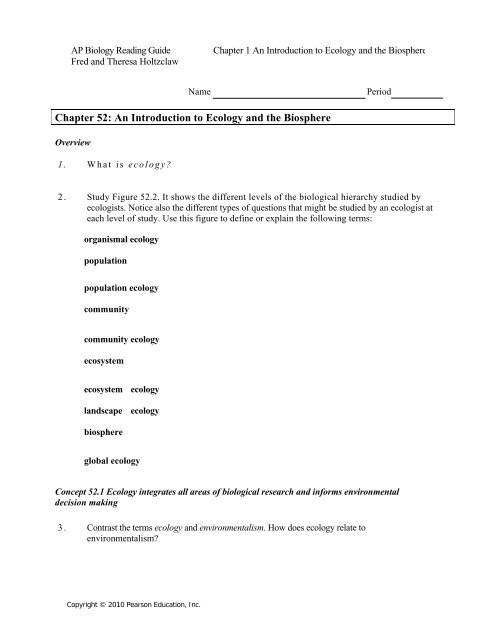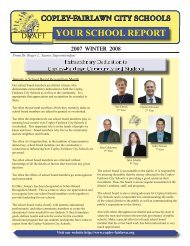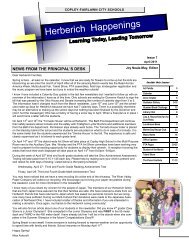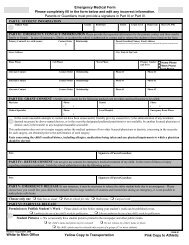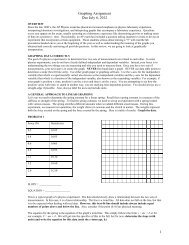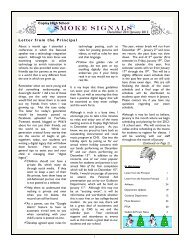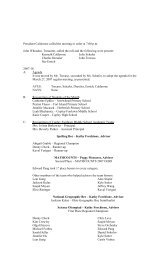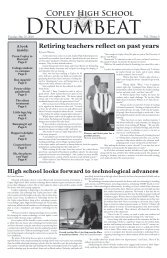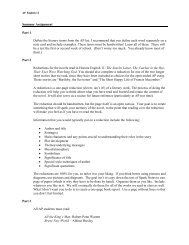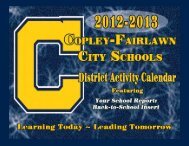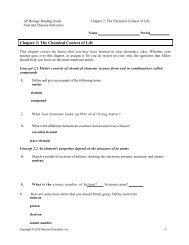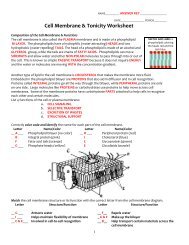Chapter 52: An Introduction to Ecology and the Biosphere
Chapter 52: An Introduction to Ecology and the Biosphere
Chapter 52: An Introduction to Ecology and the Biosphere
You also want an ePaper? Increase the reach of your titles
YUMPU automatically turns print PDFs into web optimized ePapers that Google loves.
AP Biology Reading Guide <strong>Chapter</strong> 1 <strong>An</strong> <strong>Introduction</strong> <strong>to</strong> <strong>Ecology</strong> <strong>and</strong> <strong>the</strong> <strong>Biosphere</strong><br />
Fred <strong>and</strong> Theresa Holtzclaw<br />
Name<br />
Period<br />
<strong>Chapter</strong> <strong>52</strong>: <strong>An</strong> <strong>Introduction</strong> <strong>to</strong> <strong>Ecology</strong> <strong>and</strong> <strong>the</strong> <strong>Biosphere</strong><br />
Overview<br />
1. What is ecology<br />
2. Study Figure <strong>52</strong>.2. It shows <strong>the</strong> different levels of <strong>the</strong> biological hierarchy studied by<br />
ecologists. Notice also <strong>the</strong> different types of questions that might be studied by an ecologist at<br />
each level of study. Use this figure <strong>to</strong> define or explain <strong>the</strong> following terms:<br />
organismal ecology<br />
population<br />
population ecology<br />
community<br />
community ecology<br />
ecosystem<br />
ecosystem ecology<br />
l<strong>and</strong>scape ecology<br />
biosphere<br />
global ecology<br />
Concept <strong>52</strong>.1 <strong>Ecology</strong> integrates all areas of biological research <strong>and</strong> informs environmental<br />
decision making<br />
3. Contrast <strong>the</strong> terms ecology <strong>and</strong> environmentalism. How does ecology relate <strong>to</strong><br />
environmentalism<br />
Copyright © 2010 Pearson Education, Inc.
AP Biology Reading Guide <strong>Chapter</strong> 2 <strong>An</strong> <strong>Introduction</strong> <strong>to</strong> <strong>Ecology</strong> <strong>and</strong> <strong>the</strong> <strong>Biosphere</strong><br />
Fred <strong>and</strong> Theresa Holtzclaw<br />
hat environmental issue was targeted in Rachel Carson's book, Silent Spring What was <strong>the</strong><br />
outcome of her efforts<br />
4. W<br />
Concept <strong>52</strong>.2 Interactions between organisms <strong>and</strong> <strong>the</strong> environment limit <strong>the</strong> distribution of species<br />
5. What is biogeography What fac<strong>to</strong>rs determine <strong>the</strong> distribution of organisms<br />
6. Read this section carefully <strong>to</strong> underst<strong>and</strong> different types of experiments <strong>and</strong> observations that<br />
help explain <strong>the</strong> distribution of species. As you conclude this section, list <strong>and</strong> describe five<br />
examples of biotic fac<strong>to</strong>rs.<br />
Biotic Fac<strong>to</strong>r Example <strong>and</strong> Description<br />
7. List five abiotic fac<strong>to</strong>rs. Include an example <strong>and</strong> description of each fac<strong>to</strong>r's influence on living<br />
organisms.<br />
Abiotic Fac<strong>to</strong>r<br />
Example <strong>and</strong> Description<br />
Copyright © 2010 Pearson Education, Inc.
AP Biology Reading Guide <strong>Chapter</strong> 3 <strong>An</strong> <strong>Introduction</strong> <strong>to</strong> <strong>Ecology</strong> <strong>and</strong> <strong>the</strong> <strong>Biosphere</strong><br />
Fred <strong>and</strong> Theresa Holtzclaw<br />
hat is climate What abiotic fac<strong>to</strong>rs are its components<br />
8. W<br />
9. Study Figure <strong>52</strong>.10, which summarizes Earth's climate patterns <strong>and</strong> how <strong>the</strong>y are formed.<br />
Explain how Earth's curvature <strong>and</strong> axis of rotation influence <strong>the</strong> amount of sunlight reaching a<br />
given area, <strong>and</strong> how <strong>the</strong>se fac<strong>to</strong>rs influence <strong>the</strong> temperature <strong>and</strong> precipitation in that area.<br />
10. Let's look at fac<strong>to</strong>rs that affect climate on a smaller scale. Begin by studying Figure <strong>52</strong>.11.<br />
Why is <strong>the</strong> Pacific Northwest so rainy What causes <strong>the</strong> Mediterranean climate<br />
Copyright © 2010 Pearson Education, Inc.
AP Biology Reading Guide <strong>Chapter</strong> 4 <strong>An</strong> <strong>Introduction</strong> <strong>to</strong> <strong>Ecology</strong> <strong>and</strong> <strong>the</strong> <strong>Biosphere</strong><br />
Fred <strong>and</strong> Theresa Holtzclaw<br />
11. Explain <strong>the</strong> "rain shadow" effect.<br />
12. What effect does elevation have on climate Why do we say that hiking from Gatlinburg,<br />
Tennessee, at 393 meters of elevation in <strong>the</strong> Smoky Mountains region, <strong>to</strong> <strong>the</strong> <strong>to</strong>p of Mount<br />
LeConte, at 2010 meters, is like traveling <strong>to</strong> Canada<br />
Concept <strong>52</strong>.3 Aquatic biomes are diverse <strong>and</strong> dynamic systems that cover most of Earth<br />
13. What is a biome<br />
14. What is <strong>the</strong> largest marine biome, <strong>and</strong> how much of Earth's surface does it cover<br />
15. As you read this section <strong>and</strong> study Figure <strong>52</strong>.18, you will encounter a number of new terms.<br />
Distinguish between each of <strong>the</strong> following pairs of terms:<br />
photic/aphotic<br />
benthic/pelagic<br />
oligotrophic/eutrophic<br />
lit<strong>to</strong>ral zone/limnetic zone<br />
zooplank<strong>to</strong>n/phy<strong>to</strong>plank<strong>to</strong>n<br />
neritic/abyssal<br />
Copyright © 2010 Pearson Education, Inc.
AP Biology Reading Guide <strong>Chapter</strong> 5 <strong>An</strong> <strong>Introduction</strong> <strong>to</strong> <strong>Ecology</strong> <strong>and</strong> <strong>the</strong> <strong>Biosphere</strong><br />
Fred <strong>and</strong> Theresa Holtzclaw<br />
16. The aquatic biomes are listed in <strong>the</strong> chart. Give a description of <strong>the</strong> biome below its name, <strong>and</strong><br />
<strong>the</strong>n complete <strong>the</strong> o<strong>the</strong>r parts of <strong>the</strong> chart.<br />
Aquatic Biome Typical Au<strong>to</strong>trophs Typical Heterotrophs Human Impact<br />
Lakes<br />
Wetl<strong>and</strong>s<br />
Streams <strong>and</strong> rivers<br />
Estuaries<br />
Intertidal<br />
Oceanic pelagic<br />
Concept <strong>52</strong>.4 The structure <strong>and</strong> distribution of terrestrial biomes are controlled by climate <strong>and</strong><br />
disturbance<br />
17. Figure <strong>52</strong>.20 shows a climograph for some major biomes in North America. What two abiotic<br />
fac<strong>to</strong>rs shown here are most important in determining <strong>the</strong> distribution of <strong>the</strong> biome<br />
Copyright © 2010 Pearson Education, Inc.
AP Biology Reading Guide <strong>Chapter</strong> 6 <strong>An</strong> <strong>Introduction</strong> <strong>to</strong> <strong>Ecology</strong> <strong>and</strong> <strong>the</strong> <strong>Biosphere</strong><br />
Fred <strong>and</strong> Theresa Holtzclaw<br />
18. Label <strong>the</strong> axes of this figure, <strong>and</strong> identify each biome shown here. Try <strong>to</strong> do this based on your<br />
underst<strong>and</strong>ing of <strong>the</strong> figure, <strong>and</strong> <strong>the</strong>n use <strong>the</strong> text <strong>to</strong> check your answers. You will use <strong>the</strong>se<br />
biomes: temperate grassl<strong>and</strong>, temperate broadleaf forest, tropical forest, nor<strong>the</strong>rn coniferous<br />
forest, desert, tundra.<br />
19. Describe each major terrestrial biome as <strong>to</strong> rainfall, temperature, location, <strong>and</strong> representative<br />
flora <strong>and</strong> fauna.<br />
tropical forest<br />
desert<br />
savanna<br />
Copyright © 2010 Pearson Education, Inc.
AP Biology Reading Guide<br />
Fred <strong>and</strong> Theresa Holtzclaw<br />
<strong>Chapter</strong> <strong>52</strong> <strong>An</strong> <strong>Introduction</strong> <strong>to</strong> <strong>Ecology</strong> <strong>and</strong> <strong>the</strong> <strong>Biosphere</strong><br />
chaparral<br />
temperate grassl<strong>and</strong><br />
nor<strong>the</strong>rn coniferous forest/taiga<br />
temperate broadleaf forest<br />
tundra<br />
Testing Your Knowledge: Self-Quiz <strong>An</strong>swers<br />
Now you should be ready <strong>to</strong> test your knowledge. Place your answers here:<br />
1. 2. 3. 4. 5. 6. 7. 8. 9.<br />
Copyright © 2010 Pearson Education, Inc.
AP Biology Reading Guide <strong>Chapter</strong> 54: Community <strong>Ecology</strong><br />
Fred <strong>and</strong> Theresa Holtzclaw<br />
Name<br />
Period<br />
<strong>Chapter</strong> 53: Population <strong>Ecology</strong><br />
The next three chapters on population, community, <strong>and</strong> ecosystem ecology provide <strong>the</strong> academic<br />
backbone for this unit on ecology. Each chapter is a different organizational level in ecology, starting<br />
with population ecology. Before beginning your study of each chapter, be sure you have a clear<br />
underst<strong>and</strong>ing of <strong>the</strong> terms in <strong>the</strong> chapter title.<br />
Concept 53.1 Dynamic biological processes influence population density, dispersion, <strong>and</strong><br />
demographics<br />
1. What two pieces of data are needed <strong>to</strong> ma<strong>the</strong>matically determine density<br />
2. What is <strong>the</strong> difference between density <strong>and</strong> dispersion<br />
3. Work through Figure 53.2, doing <strong>the</strong> math <strong>to</strong> make sure you get <strong>the</strong> same answer as <strong>the</strong> text.<br />
Note <strong>and</strong> underst<strong>and</strong> what <strong>the</strong> letters of <strong>the</strong> formula mean. Next, try <strong>the</strong> following problem.<br />
A population ecologist wished <strong>to</strong> determine <strong>the</strong> size of a population of white-footed deer mice,<br />
Peromyscus leucopus, in a 1-hectare field. Her first trapping yielded 80 mice, all of which<br />
were marked with a dab of purple hair dye on <strong>the</strong> back of <strong>the</strong> neck. Two weeks later, <strong>the</strong><br />
trapping was repeated. This time 75 mice were trapped, out of which 48 of <strong>the</strong> mice were<br />
marked. Using <strong>the</strong> formula N = mn/x, what is <strong>the</strong> population of mice in <strong>the</strong> field (<strong>An</strong>swer is at<br />
<strong>the</strong> end of this reading guide.)<br />
4. Explain <strong>the</strong> impact of immigration <strong>and</strong> emigration on population density. (To avoid confusion<br />
between <strong>the</strong>se two terms, it might help <strong>to</strong> use this memory trick: immigration is <strong>the</strong> movement<br />
in<strong>to</strong> a population, while migration is <strong>the</strong> exiting of individuals from a population.)<br />
Copyright 2010 Pearson Education, Inc.- 1
AP Biology Reading Guide <strong>Chapter</strong> 54: Community <strong>Ecology</strong><br />
Fred <strong>and</strong> Theresa Holtzclaw<br />
5. Label <strong>the</strong> dispersion pattern shown by each population in <strong>the</strong> figure below. Second, <strong>and</strong> most<br />
important, what do <strong>the</strong> dispersion patterns tell us about <strong>the</strong> population <strong>and</strong> its interactions<br />
6. In what population statistic do demographers have a particular interest How is this data often<br />
presented<br />
7. Is your biology class a cohort Explain.<br />
8. Survivorship curves show patterns of survival. In general terms, survivorship curves can be<br />
classified in<strong>to</strong> three types. Using <strong>the</strong> figure below, label <strong>and</strong> explain <strong>the</strong> three idealized<br />
survivorship patterns.<br />
100<br />
Copyright © 2010 Pearson Education, Inc. - 2 -
AP Biology Reading Guide <strong>Chapter</strong> 54: Community <strong>Ecology</strong><br />
Fred <strong>and</strong> Theresa Holtzclaw<br />
9. I<br />
n <strong>the</strong> natural world, many species show survivorship curves that are combinations of <strong>the</strong><br />
st<strong>and</strong>ard curves. How would an open nesting songbird's survivorship curve appear if it was<br />
Type III for <strong>the</strong> first year <strong>and</strong> <strong>the</strong>n Type II for <strong>the</strong> rest of its life span Sketch this curve on <strong>the</strong><br />
survivorship curve graph in question 8.<br />
10. What does a reproductive table show Concept<br />
53.2 Life his<strong>to</strong>ry traits are products of natural selection<br />
11. On what is <strong>the</strong> life his<strong>to</strong>ry of an organism based<br />
12. What three variables form <strong>the</strong> life his<strong>to</strong>ry of a species<br />
13. Explain <strong>the</strong> difference between semelparity (big-bang reproduction) <strong>and</strong> iteroparity (repeated<br />
reproduction) as life his<strong>to</strong>ry strategies.<br />
14. Explain how two critical fac<strong>to</strong>rs influence whe<strong>the</strong>r a species will evolve <strong>to</strong>ward semelparity or<br />
iteroparity.<br />
15. Explain <strong>the</strong> effect of offspring care on parental survival in kestrels.<br />
Concept 53.3 The exponential model describes population growth in an idealized, unlimited<br />
environment<br />
Do not let <strong>the</strong> math in this section be a problem. Instead of trying <strong>to</strong> underst<strong>and</strong> <strong>the</strong> calculus involved,<br />
concentrate on <strong>the</strong> idea of exponential growth, how it is graphed, <strong>and</strong> what this type of growth<br />
indicates about a population.<br />
16. What is <strong>the</strong> advantage <strong>to</strong> using per capita birth <strong>and</strong> death rates ra<strong>the</strong>r than just <strong>the</strong> raw numbers<br />
of births <strong>and</strong> deaths<br />
Copyright @ 2010 Pearson Education, Inc. 3
AP Biology Reading Guide <strong>Chapter</strong> 54: Community <strong>Ecology</strong><br />
Fred <strong>and</strong> Theresa Holtzclaw<br />
17. W<br />
hat will <strong>the</strong> per capita birth <strong>and</strong> death rates be if a population is demonstrating zero<br />
population growth<br />
18. What does it mean for a population <strong>to</strong> be in exponential population growth<br />
19. In <strong>the</strong> graph below, explain why <strong>the</strong> line with <strong>the</strong> value of 1.0 shows a steeper slope that<br />
reaches exponential growth more quickly than does <strong>the</strong> line with <strong>the</strong> value of 0.5. On this<br />
graph, add a third line that approximates a population with an exponential value of 1.25.<br />
20. What are two examples of conditions that might lead <strong>to</strong> exponential population growth in<br />
dN<br />
— .0 N<br />
dt<br />
dt<br />
— dal! 00.5N<br />
a<br />
500<br />
0<br />
0<br />
5 10 15<br />
Number of generations<br />
natural populations<br />
Concept 53.4 The logistic model describes how a population grows more slowly as it nears its<br />
carrying capacity<br />
21. What is carrying capacity<br />
22. What are six examples of limiting resources that can influence carrying capacity<br />
23. In <strong>the</strong> logistic population growth model, <strong>the</strong> per capita rate of increase approaches zero as <strong>the</strong><br />
is reached.<br />
Copyright @ 2010 Pearson Education, Inc. 4
AP Biology Reading Guide <strong>Chapter</strong> 54: Community <strong>Ecology</strong><br />
Fred <strong>and</strong> Theresa Holtzclaw<br />
24. If <strong>the</strong> carrying capacity (or K) is 1,000 <strong>and</strong> N is 10, <strong>the</strong> term (K — 1\)1K is large. Explain why a<br />
large value for (K — N)I K predicts growth close <strong>to</strong> <strong>the</strong> maximum rate of increase for this<br />
population.<br />
25. In <strong>the</strong> graph below, explain why <strong>the</strong> logistic model predicts a sigmoid (S-shaped) growth curve<br />
when <strong>the</strong> population density is plotted over time. Hint: The critical part of this answer concerns<br />
why growth slows as N approaches K.<br />
2,000<br />
5 10 15<br />
Number of generations<br />
26. The end of this concept attempts <strong>to</strong> bring <strong>to</strong>ge<strong>the</strong>r <strong>the</strong> ideas of life his<strong>to</strong>ries <strong>and</strong> growth models.<br />
This is done with <strong>the</strong> introduction of two new terms: K-selection <strong>and</strong> r-selection. Explain <strong>the</strong><br />
ideas behind <strong>the</strong> creation of <strong>the</strong>se two terms.<br />
27. Compare <strong>and</strong> contrast <strong>the</strong>se two terms:<br />
density-independent regulation<br />
density-dependent regulation<br />
28. Explain how negative feedback plays an essential role in <strong>the</strong> unifying <strong>the</strong>me of regulation of<br />
populations. Does negative feedback play a role in both density-independent <strong>and</strong> densitydependent<br />
regulation<br />
Copyright @ 2010 Pearson Education, Inc. 5
AP Biology Reading Guide <strong>Chapter</strong> 54: Community <strong>Ecology</strong><br />
Fred <strong>and</strong> Theresa Holtzclaw<br />
2<br />
9. Complete <strong>the</strong> following chart.<br />
Density-Dependent Population Regulation<br />
Negative Feedback<br />
Explanation<br />
Mechanism<br />
Example<br />
Competion for resources<br />
Terri<strong>to</strong>riality<br />
Disease<br />
Predation<br />
Toxic wastes<br />
Intrinsic fac<strong>to</strong>rs<br />
30. Give both biotic <strong>and</strong> abiotic reasons for population fluctuations over <strong>the</strong> last 50 years in <strong>the</strong><br />
moose population on Isle Royale, based on population dynamics.<br />
31. Explain <strong>the</strong> importance of immigration <strong>and</strong> emigration in metapopulations.<br />
Concept 53.5 The human population is no longer growing exponentially but is still increasing<br />
rapidly<br />
32. Summarize human population growth since 1650. (Of all <strong>the</strong> reported statistics, which one<br />
surprises you <strong>the</strong> most)<br />
Copyright @ 2010 Pearson Education, Inc. 6
AP Biology Reading Guide <strong>Chapter</strong> 54: Community <strong>Ecology</strong><br />
Fred <strong>and</strong> Theresa Holtzclaw<br />
33. What is demographic transition Use <strong>the</strong> figure below <strong>to</strong> explain <strong>the</strong> process in Sweden <strong>and</strong><br />
Mexico.<br />
a 50<br />
o.<br />
0<br />
o.<br />
• 40<br />
k<br />
Is 20 -<br />
a<br />
a<br />
0 • 10 Sweden Mexico<br />
.c<br />
• — Birth<br />
rate<br />
—<br />
Birt<br />
h<br />
rate<br />
Deat<br />
h<br />
rate<br />
—<br />
Deat<br />
h<br />
rate<br />
• 0<br />
1850 1900<br />
Year<br />
1950 2000 2050<br />
1750 1800<br />
34. You should be able <strong>to</strong> look at age-structure graphs <strong>and</strong> make predictions about <strong>the</strong> future<br />
growth of <strong>the</strong> population. Using Figure 53.25, describe <strong>the</strong> key features for <strong>the</strong> three agestructure<br />
graphs <strong>and</strong> predict how <strong>the</strong> population of each country will grow.<br />
Country Key Features Predicted Future Growth<br />
Afghanistan<br />
United States<br />
Italy<br />
35. Why do infant mortality <strong>and</strong> life expectancy vary so greatly between certain countries<br />
36. Can <strong>the</strong> world's population sustain an ecological footprint that is currently <strong>the</strong> average<br />
American footprint Explain.<br />
Testing Your Knowledge: Self-Quiz <strong>An</strong>swers<br />
Now you should be ready <strong>to</strong> test your knowledge. Place your answers here:<br />
1.__________2. _____ 3. ______ 4. _____ 5. ______ 6. _______ 7. ______ 8. _____ 9. ______ 10. ______<br />
Copyright @ 2010 Pearson Education, Inc. 7
AP Biology Reading Guide <strong>Chapter</strong> 54: Community <strong>Ecology</strong><br />
Fred <strong>and</strong> Theresa Holtzclaw<br />
<strong>An</strong><br />
swer <strong>to</strong> Question 3: 125 P. leucopus<br />
Copyright @ 2010 Pearson Education, Inc. 8
AP Biology Reading Guide <strong>Chapter</strong> 54: Community <strong>Ecology</strong><br />
Fred <strong>and</strong> Theresa Holtzclaw<br />
N<br />
ame<br />
Period<br />
<strong>Chapter</strong> 54: Community <strong>Ecology</strong><br />
Concept 54.1 Community interactions are classified by whe<strong>the</strong>r <strong>the</strong>y help, harm, or have no effect<br />
on <strong>the</strong> species involved.<br />
1. What is a community List six organisms that would be found in your schoolyard community.<br />
2. This section will look at interspecific interactions. Be clear on <strong>the</strong> meaning of <strong>the</strong> prefix! To<br />
begin, distinguish between intraspecific competition <strong>and</strong> interspecific competition. Give an<br />
example of each.<br />
Type of Explanation<br />
Example<br />
Competition<br />
Intraspecific<br />
competition<br />
Interspecific<br />
competition<br />
3. What is G. F. Gause's competitive exclusion principle Give one example.<br />
4. Define ecological niche.<br />
5. Several species of <strong>An</strong>olis lizards live in <strong>the</strong> same types of trees <strong>and</strong> have a similar diet. Discuss<br />
resource partitioning <strong>to</strong> explain how interspecific competition is reduced. (Study Figure 54.2.)<br />
6. What is <strong>the</strong> difference between <strong>the</strong> fundamental niche <strong>and</strong> <strong>the</strong> realized niche<br />
Copyright @ 2010 Pearson Education, Inc. 9
AP Biology Reading Guide <strong>Chapter</strong> 54: Community <strong>Ecology</strong><br />
Fred <strong>and</strong> Theresa Holtzclaw<br />
7. S<br />
tudy Figure 54.5, <strong>and</strong> <strong>the</strong>n explain what is meant by character displacement. (To do this, you<br />
will have <strong>to</strong> learn or review <strong>the</strong> difference between sympatric populations <strong>and</strong> allopatric<br />
populations. You will find this information in <strong>Chapter</strong> 24.)<br />
8. Predation is a term that you probably already know. Can you give examples of some<br />
preda<strong>to</strong>r-prey combinations as listed below<br />
Preda<strong>to</strong>r Prey Example<br />
<strong>An</strong>imal<br />
<strong>An</strong>imal<br />
Fungus<br />
Bacteria<br />
Fungus<br />
<strong>An</strong>imal<br />
Plant<br />
<strong>An</strong>imal<br />
<strong>An</strong>imal<br />
Plant<br />
9. List three special adaptations that preda<strong>to</strong>r species possess for obtaining food.<br />
10. List three ways prey species elude preda<strong>to</strong>rs.<br />
11. Compare <strong>the</strong> two types of mimicry.<br />
Type of Mimicry Description Example<br />
Batesian<br />
Midlerian<br />
12. What is herbivory<br />
Copyright @ 2010 Pearson Education, Inc. 2
AP Biology Reading Guide <strong>Chapter</strong> 54: Community <strong>Ecology</strong><br />
Fred <strong>and</strong> Theresa Holtzclaw<br />
13. D<br />
id you list any special herbivore adaptations for predation in your response <strong>to</strong> question 9 Or<br />
plant adaptations <strong>to</strong> avoid herbivory List two adaptations for each category here.<br />
14. Describe <strong>and</strong> give an example of each of <strong>the</strong> following interactions:<br />
Type of Description<br />
Example<br />
Interaction<br />
symbiosis<br />
parasitism<br />
commensalism<br />
mutualism<br />
15. Which category above includes <strong>the</strong> o<strong>the</strong>r three Note that o<strong>the</strong>r texts may define this term<br />
more narrowly.<br />
16. Your text uses +1— symbols <strong>to</strong> indicate how interspecific interactions affect survival <strong>and</strong><br />
reproduction of <strong>the</strong> two species. Use this notation for each of <strong>the</strong>se interactions.<br />
Type of Interaction +1+ , +1 - , - 4 - 9 +10<br />
predation<br />
commensalism<br />
mutualism<br />
parasitism<br />
interspecific competition<br />
herbivory<br />
Copyright @ 2010 Pearson Education, Inc. 3
AP Biology Reading Guide <strong>Chapter</strong> 54: Community <strong>Ecology</strong><br />
Fred <strong>and</strong> Theresa Holtzclaw<br />
17. W<br />
hat is species diversity What are its two components Why is it important<br />
18. What does an ecologist summarize in a food web<br />
19. Know <strong>the</strong> levels of trophic structure in food chains. Give a food chain here, including four links<br />
that might be found in a prairie community, <strong>and</strong> tell <strong>the</strong> level for each organism.<br />
20. Name every organism in <strong>the</strong> pictured food chain, <strong>and</strong> give <strong>the</strong> trophic level in <strong>the</strong> box.<br />
21. According <strong>to</strong> <strong>the</strong> energetic hypo<strong>the</strong>sis, why are food chains limited in length How much<br />
energy is typically transferred <strong>to</strong> each higher level<br />
22. What is a dominant species For <strong>the</strong> area where you live, what would be considered a dominant<br />
tree species<br />
Copyright @ 2010 Pearson Education, Inc. 4
AP Biology Reading Guide <strong>Chapter</strong> 54: Community <strong>Ecology</strong><br />
Fred <strong>and</strong> Theresa Holtzclaw<br />
23. H<br />
ow is a keys<strong>to</strong>ne species different from a dominant species<br />
24. Name one keys<strong>to</strong>ne species, <strong>and</strong> explain <strong>the</strong> effect its removal has on <strong>the</strong> ecosystem.<br />
25. Explain facilita<strong>to</strong>r or foundation species <strong>and</strong> give an example.<br />
You may omit bot<strong>to</strong>m-up <strong>and</strong> <strong>to</strong>p-down controls.<br />
Concept 54.2 Disturbance influences species diversity <strong>and</strong> composition<br />
26. What is <strong>the</strong> intermediate disturbance hypo<strong>the</strong>sis Give an example of a disturbance event, <strong>and</strong><br />
explain <strong>the</strong> effect it has on <strong>the</strong> community.<br />
27. Ecological succession is <strong>the</strong> changes in species that occupy an area after a disturbance. What is<br />
<strong>the</strong> difference between primary succession <strong>and</strong> secondary succession<br />
Concept 54.3 Biogeographic fac<strong>to</strong>rs affect community biodiversity<br />
28. Explain latitudinal gradients in terms of species richness. Where is species richness greatest<br />
29. There are probably two key fac<strong>to</strong>rs in latitudinal gradients. List <strong>and</strong> explain both here, <strong>and</strong> put a<br />
star next <strong>to</strong> <strong>the</strong> one that is probably <strong>the</strong> primary cause of <strong>the</strong> latitudinal difference in<br />
biodiversity.<br />
30. Explain what is demonstrated by a species-area curve.<br />
Copyright @ 2010 Pearson Education, Inc. 5
AP Biology Reading Guide <strong>Chapter</strong> 54: Community <strong>Ecology</strong><br />
Fred <strong>and</strong> Theresa Holtzclaw<br />
31. R<br />
enowned American ecologists Robert MacArthur <strong>and</strong> E. 0. Wilson developed a model of<br />
isl<strong>and</strong> biogeography. While <strong>the</strong> model can be demonstrated with isl<strong>and</strong>s, any isolated habitat<br />
represents an isl<strong>and</strong>. What are <strong>the</strong> two fac<strong>to</strong>rs that determine <strong>the</strong> number of species on <strong>the</strong><br />
isl<strong>and</strong><br />
32. What two physical features of <strong>the</strong> isl<strong>and</strong> affect immigration <strong>and</strong> extinction rates<br />
33. Why do small isl<strong>and</strong>s have lower immigration rates Higher extinction rates<br />
34. Closer isl<strong>and</strong>s 35. extinction rates <strong>and</strong> immigration rates.<br />
36. What is <strong>the</strong> isl<strong>and</strong> equilibrium model<br />
37. Use this model <strong>to</strong> describe how an isl<strong>and</strong>'s size <strong>and</strong> distance from <strong>the</strong> mainl<strong>and</strong> affect <strong>the</strong><br />
isl<strong>and</strong>'s species richness.<br />
38. Label this figure <strong>to</strong> show immigration, extinction, isl<strong>and</strong> size, <strong>and</strong> equilibrium. Then explain<br />
what each figure shows.<br />
Copyright @ 2010 Pearson Education, Inc. 6
AP Biology Reading Guide <strong>Chapter</strong> 54: Community <strong>Ecology</strong><br />
Fred <strong>and</strong> Theresa Holtzclaw<br />
Co<br />
ncept 54.4 Community ecology is useful for underst<strong>and</strong>ing pathogen life cycles <strong>and</strong> controlling<br />
human disease<br />
38. Let's pull a couple of ideas from this section: What is a pathogen<br />
39. What is a zoonotic pathogen List three examples.<br />
40. What is a vec<strong>to</strong>r List three examples.<br />
Testing Your Knowledge: Self-Quiz <strong>An</strong>swers<br />
Now you should be ready <strong>to</strong> test your knowledge. Place your answers here:<br />
1. 2. 3. 4. 5. 6. 7. 8. 9.<br />
Copyright @ 2010 Pearson Education, Inc. 7
AP Biology Reading Guide <strong>Chapter</strong> 55: Ecosystems<br />
Fred <strong>and</strong> Theresa Holtzclaw<br />
Name<br />
Period<br />
<strong>Chapter</strong> 55: Ecosystems<br />
Overview:<br />
1. What is an ecosystem<br />
Where does energy enter most ecosystems How is it converted <strong>to</strong> chemical energy <strong>and</strong> <strong>the</strong>n<br />
passed through <strong>the</strong> ecosystem How is it lost Remember this: energy cannot be recycled.<br />
3. Besides <strong>the</strong> energy flow that you described in question 2, chemicals such as carbon <strong>and</strong><br />
nitrogen cycle through ecosystems. So energy ______________ through an ecosystem <strong>and</strong><br />
matter<br />
Concept 55.1 Physical laws govern energy flow <strong>and</strong> chemical cycling in ecosystems<br />
4. Both energy <strong>and</strong> matter can be nei<strong>the</strong>r ____________________ nor<br />
5. We can measure <strong>the</strong> efficiency of energy conversion in an ecosystem, as well as whe<strong>the</strong>r a<br />
given nutrient is being gained or lost from an ecosystem. Let us take a second look at trophic<br />
levels. What trophic level supports all o<strong>the</strong>rs<br />
6. List three groups of organisms that are pho<strong>to</strong>syn<strong>the</strong>tic au<strong>to</strong>trophs.<br />
7. What are <strong>the</strong> primary producers of <strong>the</strong> deep-sea vents<br />
8. This concept reviews trophic relationships. Know all terms in your textbook that are bolded.<br />
What are trophic levels What is always at <strong>the</strong> first trophic level<br />
Copyright 2010 Pearson Education, Inc. - 1 -
AP Biology Reading Guide <strong>Chapter</strong> 55: Ecosystems<br />
Fred <strong>and</strong> Theresa Holtzclaw<br />
9. What are detritivores What is <strong>the</strong>ir importance in chemical cycling Give some examples of<br />
detritivores.<br />
10. State <strong>the</strong> trophic level of each of <strong>the</strong> following:<br />
cow ___________ grass ______________man __________ mushroom __________<br />
Concept 55.2 Energy <strong>and</strong> o<strong>the</strong>r limiting fac<strong>to</strong>rs control primary production in ecosystems<br />
11. What is primary production Distinguish between gross primary production <strong>and</strong> net primary<br />
production.<br />
12. Write an equation here that shows <strong>the</strong> relationship between gross <strong>and</strong> net primary production.<br />
13. You may recall from <strong>Chapter</strong> 54 that biomass is <strong>the</strong> <strong>to</strong>tal mass of all individuals in a trophic<br />
level. <strong>An</strong>o<strong>the</strong>r way of defining net primary production is as <strong>the</strong> amount of new biomass added<br />
in a given period of time. Why is net primary production, or <strong>the</strong> amount of new biomass/unit of<br />
time, <strong>the</strong> key measurement <strong>to</strong> ecologists<br />
14. Which ecosystem would tend <strong>to</strong> have a greater biomass/unit area, a prairie or a tropical rain<br />
forest Explain.<br />
15. Describe a technique for measuring net primary production in an aquatic environment.<br />
(We will use this technique for AP Lab 12, Dissolved Oxygen <strong>and</strong> Aquatic Primary Productivity.)<br />
16. What are some fac<strong>to</strong>rs that limit primary productivity in aquatic ecosystems<br />
Copyright 2010 Pearson Education, Inc. - 2 -
AP Biology Reading Guide <strong>Chapter</strong> 55: Ecosystems<br />
Fred <strong>and</strong> Theresa Holtzclaw<br />
17. - What is a limiting nutrient What is <strong>the</strong> limiting nutrient off <strong>the</strong> shore of Long Isl<strong>and</strong>, New<br />
York In <strong>the</strong> Sargasso Sea<br />
18. Phy<strong>to</strong>plank<strong>to</strong>n growth can be increased by additional nitrates <strong>and</strong> phosphates. What are<br />
common sources of each of <strong>the</strong>se<br />
19. What is eutrophication What are fac<strong>to</strong>rs that contribute <strong>to</strong> eutrophication<br />
Concept 55.3 Energy transfer between trophic levels is typically only 10% efficient<br />
20. What is trophic efficiency<br />
21. Generally, what percentage of energy available at one trophic level is available at <strong>the</strong> next<br />
This is important!<br />
Remember it.<br />
22. Consider a food chain with 1,000 joules (an energy u<br />
food chain is grass 4 grasshopper lizard 4<br />
crow, how much energy is found at <strong>the</strong><br />
level of <strong>the</strong> crow (See answer at <strong>the</strong> end of<br />
this Reading Guide.) Show your work here.<br />
Copyright 2010 Pearson Education, Inc. - 3 -
AP Biology Reading Guide <strong>Chapter</strong> 55: Ecosystems<br />
Fred <strong>and</strong> Theresa Holtzclaw<br />
23. Notice that most biomass pyramids have greatest biomass on <strong>the</strong> bot<strong>to</strong>m of <strong>the</strong> pyramid. Label<br />
<strong>the</strong> trophic levels on <strong>the</strong> figure. Explain why <strong>the</strong> second pyramid of biomass is inverted.<br />
24. Why do people who have limited diets in overpopulated parts of <strong>the</strong> world eat low on <strong>the</strong> food<br />
chain<br />
Concept 55.4 Biological <strong>and</strong> geochemical processes cycle nutrients between organic <strong>and</strong> inorganic<br />
parts of an ecosystem<br />
Pay particular attention <strong>to</strong> <strong>the</strong> nutrient cycles in Figure 55.14. Note <strong>the</strong> key processes in each cycle.<br />
25. Use <strong>the</strong> figure below <strong>to</strong> describe <strong>the</strong> water cycle. Specify <strong>the</strong> roles of evaporation,<br />
transpiration, <strong>and</strong> rainfall.<br />
26. Use <strong>the</strong> second figure on <strong>the</strong> following page <strong>to</strong> describe <strong>the</strong> carbon cycle. In doing so, explain<br />
how carbon enters <strong>the</strong> living system <strong>and</strong> how it leaves, indicate <strong>the</strong> role of microorganisms<br />
in <strong>the</strong> cycle, <strong>and</strong> identify <strong>the</strong> reservoir for carbon.<br />
Copyright 2010 Pearson Education, Inc. - 4 -
AP Biology Reading Guide <strong>Chapter</strong> 55: Ecosystems<br />
Fred <strong>and</strong> Theresa Holtzclaw<br />
Write <strong>the</strong> equation for pho<strong>to</strong>syn<strong>the</strong>sis here: _________________________________________________<br />
Write <strong>the</strong> equation for cellular respiration here: ______________________________________________<br />
27. Use <strong>the</strong> diagram below <strong>to</strong> describe <strong>the</strong> nitrogen cycle. In doing so, indicate <strong>the</strong> role of<br />
microorganisms in nitrogen fixation, nitrification, <strong>and</strong> denitrification.<br />
, y e r * I e . r n , 1,..an, h-vien<br />
Copyright 2010 Pearson Education, Inc. - 5 -
AP Biology Reading Guide <strong>Chapter</strong> 55: Ecosystems<br />
Fred <strong>and</strong> Theresa Holtzclaw<br />
28. Review <strong>the</strong> Case Study: Nutrient Cycling in <strong>the</strong> Hubbard Brook Experimental Forest. What<br />
effect has deforestation been shown <strong>to</strong> have on chemical cycling<br />
Concept 55.5 Human activities now dominate most chemical cycles on Earth<br />
This section looks at human impact on ecosystems.<br />
29. How has agriculture affected nitrogen cycling What are some negative consequences of<br />
nutrient enrichment<br />
30. In what ways have human activities contributed <strong>to</strong> acid precipitation What are some negative<br />
consequences of acid precipitation<br />
31. Explain <strong>the</strong> process of biological magnification. Discuss at least one example.<br />
32. What is meant by <strong>the</strong> greenhouse effect What would life on Earth be like without this effect<br />
33. What is contributing <strong>to</strong> <strong>the</strong> great increase in atmospheric carbon dioxide What are potential<br />
effects of this increase<br />
34. How is atmospheric ozone depleted What are projected effects of this depletion<br />
Testing Your Knowledge: Self-Quiz <strong>An</strong>swers<br />
Now you should be ready <strong>to</strong> test your knowledge. Place your answers here:<br />
1. 2. 3. 4. 5. 6. 7.<br />
Solution <strong>to</strong> Question 22: Grass (1,000 J) -grasshopper (100 J) -4 lizard (10 J) 4 crow (1 J)<br />
Copyright 2010 Pearson Education, Inc. - 6 -
AP Biology Reading Guide<br />
Fred <strong>and</strong> Theresa Holtzclaw<br />
<strong>Chapter</strong> 56: Conservation Biology <strong>and</strong> Res<strong>to</strong>ration <strong>Ecology</strong><br />
Name<br />
Period<br />
<strong>Chapter</strong> 56: Conservation Biology <strong>and</strong> Res<strong>to</strong>ration <strong>Ecology</strong><br />
In <strong>the</strong> overview at <strong>the</strong> beginning of <strong>the</strong> chapter, <strong>the</strong> author sets <strong>the</strong> stage for this final chapter of <strong>the</strong><br />
book. This chapter will deal with both conservation biology <strong>and</strong> res<strong>to</strong>ration ecology. Let's begin by<br />
comparing <strong>and</strong> contrasting <strong>the</strong>se two terms.<br />
conservation biology<br />
res<strong>to</strong>ration ecology<br />
Concept 56.1 Human activities threaten Earth's biodiversity<br />
1. Ecologists organize biodiversity on three levels. In <strong>the</strong> table below, explain <strong>the</strong> impact of<br />
decreasing diversity in each division. Begin reading on page 1248, where <strong>the</strong> <strong>to</strong>pic changes <strong>to</strong><br />
threats <strong>to</strong> biodiversity before answering this question.<br />
Level of Biodiversity<br />
Impact<br />
Genetic diversity<br />
Species diversity<br />
Ecosystem diversity<br />
2. Explain <strong>the</strong> difference between endangered species <strong>and</strong> threatened species.<br />
3. Use this table <strong>to</strong> organize your thoughts on how <strong>the</strong> following three threats affect biodiversity.<br />
Threat <strong>to</strong> Biodiversity<br />
How it reduces biodiversity<br />
Habitat loss<br />
Introduced species<br />
Overexploitation<br />
Copyright © 2010 Pearson Education, Inc. -7-
AP Biology Reading Guide<br />
Fred <strong>and</strong> Theresa Holtzclaw<br />
<strong>Chapter</strong> 56: Conservation Biology <strong>and</strong> Res<strong>to</strong>ration <strong>Ecology</strong><br />
4.<br />
List five introduced species that present a serious threat <strong>to</strong> <strong>the</strong>ir new communities. Explain <strong>the</strong><br />
damage done by each introduced species. ***Include two introduced species that are a threat in<br />
your own region of <strong>the</strong> country. Indicate <strong>the</strong>se with an asterisk.<br />
Introduced Species Damage<br />
(1)<br />
(2)<br />
(3)<br />
(4)<br />
(5)<br />
Concept 56.2 Population conservation focuses on population size, genetic diversity, <strong>and</strong> critical<br />
habitat<br />
5. What do conservation biologists who adopt <strong>the</strong> small-population approach study<br />
6. Explain what an extinction vortex is, <strong>and</strong> describe one field study that supports this idea.<br />
7. Why is genetic variation <strong>the</strong> key issue in <strong>the</strong> small-population approach<br />
8. On what type of population does <strong>the</strong> declining-population model focus<br />
9. What is <strong>the</strong> emphasis for study in <strong>the</strong> declining-population model<br />
Copyright © 2010 Pearson Education, Inc. -2-
AP Biology Reading Guide<br />
Fred <strong>and</strong> Theresa Holtzclaw<br />
<strong>Chapter</strong> 56: Conservation Biology <strong>and</strong> Res<strong>to</strong>ration <strong>Ecology</strong><br />
10. S<br />
cientists drilled nest holes for red-cockaded woodpeckers in an attempt, <strong>to</strong> increase <strong>the</strong>ir<br />
population levels. How is this action a response <strong>to</strong> <strong>the</strong> declining-population model<br />
Concept 56.3 L<strong>and</strong>scape <strong>and</strong> regional conservation aim <strong>to</strong> sustain entire biotas<br />
11. Describe how <strong>the</strong> increase in cowbirds is related <strong>to</strong> forest fragmentation.<br />
12. What are potential positive <strong>and</strong> negative effects of movement corridors<br />
13. Explain <strong>the</strong> concept behind a zoned reserve.<br />
Concept 56.4 Res<strong>to</strong>ration ecology attempts <strong>to</strong> res<strong>to</strong>re degraded ecosystems <strong>to</strong> a more natural state<br />
14. What is <strong>the</strong> goal of res<strong>to</strong>ration ecology<br />
15. Res<strong>to</strong>ration ecology uses two key strategies. Explain how each strategy works:<br />
bioremediation<br />
biological augmentation<br />
Concept 56.5 Sustainable development seeks <strong>to</strong> improve <strong>the</strong> human condition while conserving<br />
biodiversity<br />
16. Explain <strong>the</strong> concept behind <strong>the</strong> phrase "sustainable development."<br />
Copyright © 2010 Pearson Education, Inc. -3-
Testing Your Knowledge: Self-Quiz <strong>An</strong>swers<br />
Now you should be ready <strong>to</strong> test your knowledge. Place your answers here:<br />
1. 2. 3. 4. 5. 6. 7. 8. 9.<br />
Kudzu, <strong>the</strong> wonder vine! Will not climb!


